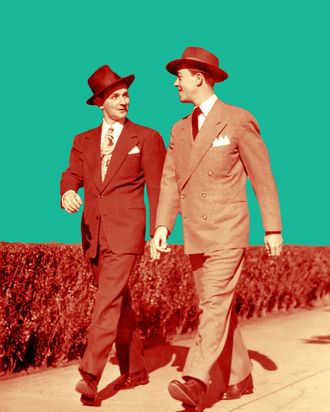
The best part of New York is that you walk everywhere. The worst part of New York is that you walk everywhere. With all that walking, it’s a miracle that we’re not constantly spilling coffees and cracking iPhones from stumbling into one another. According to new research, this fascinatingly civil ability boils down to the kind of pedestrian you are.
The study, lead by Alexander Knorr at Ludwig-Maximilians University, in Munich, set out to see how and why people navigated would-be collisions with pedestrians walking down their path. Previous research had found that the way people avoided stumbling into a stranger had to do with gender, height, or personality — like how aggressive or shy you are. Knorr and his team wanted to see whether it was personality or situation that shaped the collisions (or lack thereof), so they ran two studies.
In the first study, 20 participants — split evenly between genders — were asked to walk diagonally across rooms in pairs, for a total of 90 different walking pairs and 270 trials. They also took tests measuring 14 personality traits, from achievement-orientation to aggression to impulsivity. In each walking trial, participants — outfitted with fancy reflective sensors to aid video recording — walked from one corner of the room to the opposite over a distance of about 22 feet. After crunching the numbers, the authors didn’t find correlations between gender, height, or personality traits for how they walked into someone. Rather, the data suggested that participants have a preferred mode of collision avoidance: They either almost always went first, or they almost always gave way, or they adjusted their strategy depending on what the other person was doing. In a second experiment, the authors found that “role attribution” — whether you’re going to be the first or second to pass — can be predicted even before people start adjusting their walking trajectory. It’s signaled super early.
This lends an insight into a particular dilemma of sidewalk and hallway awkwardness: How do you decide who’s giving way? The authors say that when the person to go first adjusts their path — and indeed, there were always adjustments on both sides — it gives a “symbolic cue” to the way-giver. With that cue given, there’s less of a chance of what the authors gently call “conflicting role assignment,” or that that cringe-inducing game of chicken when you don’t know who’s going left or who’s going right and you end up shuffling to one side together, like some sort of unfortunate, spontaneous line dance. It also helps name the pain of an smartphone-saturated, pedestrian-friendly metropolis: When you’re thumbing at your phone walking down Canal Street, you’re not just clueless; you’re cueless.




